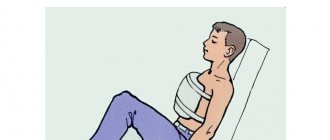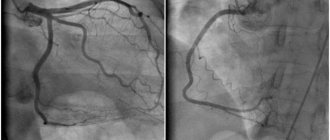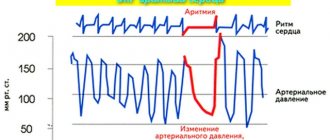On average, 7-10% of Russians have chronic heart failure (CHF), 4.5% suffer from clinical symptoms of heart failure that reduce quality of life and ability to work, and among people over 65 years of age, half of patients with cardiovascular diseases have symptoms of CHF, and These numbers are increasing every year.
Heart failure is a syndrome caused by abnormal structure and decreased function of the heart. It can be the outcome of diseases such as arterial hypertension, coronary heart disease, heart defects, arrhythmias, kidney and thyroid diseases, cardiomyopathies, hereditary or as a result of infections, intoxications, metabolic and other disorders.
Classification
Woman on bed
Depending on the severity of the condition and the consequences for the human body, the following types of syndrome are distinguished:
- fainting;
- collapse;
- shock.
Important! All types of pathology pose a threat to human health and life; if emergency care is not provided in a timely manner, the patient develops acute heart failure and death.
Diagnostics
When collecting anamnesis, the doctor pays special attention to the presence of complaints of shortness of breath and fatigue. Collects information about the existence of other diseases. If heart failure is suspected, the patient is referred for instrumental studies and laboratory tests.
The Cardiology Center of the Federal Medical and Clinical Center of the Federal Medical and Biological Agency carries out a full range of diagnostic measures:
- ECG in 12 leads;
- ECHO-KG;
- Holter monitoring;
- ECG with dosed physical activity;
- transesophageal ECHO-CG;
- ABPM (24-hour blood pressure monitoring);
- Ultrasound of the abdominal organs;
- general blood analysis;
- biochemical blood test (lipid spectrum, blood glucose, liver and kidney function indicators);
- thyroid hormones;
- coagulogram (a test to determine blood clotting);
- general urine analysis;
- spirometry (respiratory function test);
Pathogenesis and causes
Why does fainting occur?
The entire human body is penetrated by large and small blood vessels through which blood circulates and supplies oxygen to organs and tissues. Normal distribution of blood through the arteries occurs due to the contraction of the smooth muscles of their walls and changes in tone.
Maintaining the desired tone of arteries and veins is regulated by hormones, metabolic processes of the body and the work of the autonomic nervous system. When these processes are disrupted and hormonal imbalance occurs, there is a sharp outflow of blood from vital internal organs, as a result of which they stop working as expected.
The etiology of AHF can be very diverse; a sudden disruption of blood circulation in the vessels occurs as a result of the following conditions:
- massive blood loss;
- extensive burns;
- heart disease;
- long stay in a stuffy room;
- traumatic brain injury;
- severe fear or stress;
- acute poisoning;
- adrenal insufficiency;
- Iron-deficiency anemia;
- excessive loads with severe hypotension, as a result of which internal organs experience oxygen deficiency.
Depending on the duration of the course, vascular insufficiency can be acute or chronic.
How to treat?
If cardiopulmonary failure has entered an acute form, treatment is carried out in a hospital under the supervision of cardiologists. Often the patient is admitted to intensive care. Here the patient remains completely at rest and breathes enriched oxygen.
If thromboembolism is detected, streptokinases and actilises are used to help dissolve the thrombotic mass. When using these drugs in the first two to three hours from the onset of an exacerbation of the disease, excellent results can be achieved. In some cases, surgery is performed. However, given the serious condition of the patient, this method is not always appropriate.
If pulmonary heart failure has become chronic, antibiotics and hormone-containing drugs are used to avoid the development of infectious diseases.
Simultaneously with the treatment of pulmonary disease, therapy is carried out aimed at maintaining cardiac activity. Diuretics are prescribed to remove excess fluid from the body, and drugs that stabilize blood pressure.
Thus, cardiopulmonary failure is a serious disease that requires an integrated approach to treatment. In addition to medicinal maintenance of the body, it is important that the patient himself follows all the recommendations of cardiologists, adheres to a certain diet, and gives up drinking alcohol and smoking. At the first manifestations of the disease, you should immediately seek medical help. In case of detection of serious diseases, timely treatment and subsequent prevention play an important role.
Clinical manifestations
The syndrome usually develops suddenly
The clinical picture of AHF is always accompanied by a decrease in blood pressure and directly depends on the severity of the condition; this is presented in more detail in the table.
Table 1. Clinical forms of pathology
| Name | How does it manifest clinically? |
| Fainting woman fainting | The patient suddenly feels weak, dizzy, and has “floaters” flashing before his eyes. Consciousness may be preserved or absent. If after 5 minutes the patient does not come to his senses, then fainting is accompanied by convulsions; as a rule, this rarely happens and with properly organized help the person’s condition quickly normalizes |
| Collapse Retardation during collapse | This condition is much more severe than fainting. The patient's consciousness can be preserved, but there is severe inhibition and disorientation in space. Blood pressure is sharply reduced, the pulse is weak and thready, breathing is shallow and rapid. The skin is pale, acrocyanosis and sticky cold sweat are observed. |
Shock State of shock | Clinically, shock is not much different from collapse, but in this condition a sharp depression of the heart and other vital organs develops. Due to severe hypoxia, the brain suffers, against the background of which degenerative changes can develop in its structure |
Symptoms
In an acute state, cardiopulmonary failure manifests itself as follows:
- The patient's breathing becomes shallow.
- A person experiences suffocation and an acute lack of oxygen.
- Pallor of the skin appears.
- The patient breaks out in a cold sweat.
- There is a sharp pain in the sternum area.
If the disease becomes chronic, the symptoms manifest themselves somewhat differently. At first, the disease develops almost unnoticed by the patient. Over time, the following appear:
- dyspnea,
- cardiopalmus,
- pulsation of the veins in the neck,
- pain in the heart area,
- neurological disorders,
- swelling.
At first, these symptoms appear only after physical activity. As the disease progresses, obvious signs become more pronounced.
Fainting, collapse, shock: more about each condition
Fainting
Taking the pulse of an unconscious woman
Fainting is a form of AHF, which is characterized by the mildest course.
The causes of fainting are:
- sudden decrease in blood pressure - occurs against the background of diseases and pathologies of the cardiovascular system, which are accompanied by cardiac arrhythmias. At the slightest physical overload, blood flow in the muscles increases as a result of blood redistribution. Against this background, the heart cannot cope with the increased load, blood ejection during systole decreases, and systolic and diastolic pressure levels decrease.
- Dehydration – as a result of repeated vomiting, diarrhea, excessive urination or sweating, the volume of circulating blood through the vessels is reduced, which can cause fainting.
- Nerve impulses from the nervous system - as a result of strong feelings, fear, excitement or psycho-emotional arousal, sharp vasomotor reactions and vascular spasm occur.
- Impaired blood supply to the brain - against the background of a head injury, a minor stroke or stroke, an insufficient amount of blood and oxygen reaches the brain, which can lead to the development of fainting.
- Hypocapnia is a condition characterized by a decrease in carbon dioxide in the blood due to frequent and deep breathing, which can lead to fainting.
Collapse
Girl with collapse
Collapse is a serious impairment of vascular function. The condition develops abruptly, the patient suddenly feels weak, the legs give way, tremors of the limbs, cold sticky sweat, and a drop in blood pressure appear.
Consciousness may be preserved or impaired. There are several types of collapse.
Table 2. Types of collapse
| Types of collapse | What causes it? |
| Cardiogenic | Develops in diseases and pathologies of the heart caused by impaired cardiac output and decreased blood supply to internal organs |
| Hypovolemic | It occurs as a result of a sharp decrease in the volume of circulating blood in the body. Most often, this condition develops against the background of blood loss, dehydration, and severe burns. |
| Vasodilator | Serious disturbances in the tone of blood vessels occur, as a result of which the microcirculation of internal organs and tissues is disrupted |
Important! Only a doctor can determine the type of collapse and correctly assess the severity of the patient’s condition, so do not neglect to call an ambulance and do not self-medicate; sometimes wrong actions are the price of a person’s life.
Shock
Shock is the most severe form of acute heart failure. During shock, severe circulatory disorders develop, which may result in the death of the patient. Shock has several phases of flow.
Table 3. Shock phases
| Shock phase | How does it manifest clinically? |
| Erectile | Accompanied by sharp psychomotor agitation, the patient screams, waves his arms, tries to get up and run somewhere. Blood pressure readings are elevated, pulse is rapid |
| Torpidnaya | Quickly changes the erectile phase, sometimes even before the ambulance has time to arrive. The patient becomes lethargic, lethargic, and does not react to what is happening around him. Blood pressure levels rapidly decrease, the pulse becomes weak, thready, or cannot be felt at all. Pale skin with severe acrocyanosis, shallow breathing, shortness of breath |
| Terminal | Occurs in the absence of adequate timely assistance to the patient. Blood pressure is below critical, the pulse cannot be felt, breathing is rare or absent, the patient is unconscious, there are no reflexes. In such a situation, death quickly develops. |
Depending on the causes of shock syndrome, AHF occurs:
- hemorrhagic – develops against the background of massive blood loss;
- traumatic – develops as a result of severe trauma (road accidents, fractures, soft tissue damage);
- burn – develops as a result of severe burns and damage to a large area of the body;
- anaphylactic - an acute allergic reaction that develops due to the administration of a drug, insect bites, vaccination;
- blood transfusion - occurs against the background of transfusion of red blood cells or blood incompatible with the blood group to the patient.
The video in this article describes in detail all types of shock and the principles of emergency first aid. This instruction, of course, is for general informational purposes only and cannot replace the help of a doctor.
First aid for AHF
A patient with AHF must immediately receive emergency care, since cardiogenic shock may occur during a heart attack. At the same time, his skin turns pale, his blood pressure drops sharply, severe pain appears, and his pulse is practically not palpable. If you do not respond in time, swelling of the kidneys and lungs can quickly develop, which can lead to death.
In case of AHF, first aid is provided at the scene of the incident, while it is necessary to reduce the load and ensure the redistribution of blood flow by performing the following actions:
- Place the patient in a comfortable sitting position; to do this, lower his legs to the floor and raise his back.
- It is better to immerse your feet in a basin of hot water, reducing the flow of blood to the heart.
- Remove the patient from clothing and open the windows, ensuring maximum flow of fresh air.
- Call emergency doctors and report the symptoms of an attack.
- Apply a tourniquet in the groin area to each leg alternately (20 minutes), which will reduce the flow of blood into the myocardium.
- Provide the patient with emotional and physical peace; he is strictly forbidden to get up and walk.
If there are signs of AHF, you need to measure your blood pressure. If the upper reading is more than 90 mmHg, then 1 tablet of nitroglycerin should be placed under the patient’s tongue. After this, you need to monitor the pressure all the time. If necessary, you can give 1 more tablet after 7 minutes, but not more than 4 times.
Patients suffering from heart disease or hypertension with severe swelling of the legs and shortness of breath should always carry a first aid kit with medications prescribed by the attending physician. Then, at the first signs of AHF, people around you will be able to provide emergency assistance.
Treatment
First medical aid for AHF directly depends on the type of pathology.
Fainting
First aid for fainting
As a rule, treatment of fainting occurs without the use of medications.
Emergency care for fainting type of fainting consists of the following actions:
- place the patient in a horizontal position with the leg end raised;
- unbutton the buttons of your shirt and free yourself from clothing that is constricting your chest;
- provide access to fresh cool air;
- Spray your face with water or wipe your forehead and cheeks with a wet cloth;
- give warm sweet tea or weak coffee to drink if the patient is conscious;
- in the absence of consciousness, pat your cheeks and apply cold to your temples.
Cup of hot sweet coffee
If the above actions are ineffective, you can inject vasoconstrictor drugs, for example, Cordiamin.
Collapse
The woman in the photo suddenly felt ill
First aid for collapse is aimed at eliminating the causes that provoked the development of this condition. First aid for collapse consists of immediately placing the patient in a horizontal position, raising the leg end and warming the patient.
If the person is conscious, then you can give him hot sweet tea. Before transport to the hospital, the patient is given an injection of a vasoconstrictor drug.
Syringe for intravenous injection
In a hospital setting, the patient is administered medications that eliminate both the symptoms of vascular insufficiency and the causes of this pathological condition:
- drugs that stimulate the respiratory and cardiovascular centers - these drugs increase the tone of the arteries and increase the stroke volume of the heart;
- vasoconstrictors - adrenaline, Dopamine, Norepinephrine and other drugs that quickly increase blood pressure and stimulate the heart are administered intravenously;
- infusion of blood and red blood cells - required in case of blood loss to prevent shock;
- carrying out detoxification therapy - droppers and solutions are prescribed that quickly remove toxic substances from the blood and replenish the volume of circulating fluid;
- Oxygen therapy – prescribed to improve metabolic processes in the body and saturate the blood with oxygen.
Possible nursing problems with AHF of the collapse type are the difficulty of giving the patient something to drink if his consciousness is impaired, and of administering the drug intravenously at low pressure - it is not always possible to immediately find a vein and get into the vessel.
Important! Saline solutions are not effective if the collapse is caused by the deposition of blood into the intercellular space and internal organs. In such a situation, to improve the patient's condition, it is necessary to inject colloidal solutions into the plasma.
Shock
Treatment of shock consists of taking measures aimed at improving the systemic functions of the body and eliminating the causes of this condition.
The patient is prescribed:
- painkillers – in case of injuries and burns, before carrying out any actions, it is necessary to administer painkillers to the patient, which will help prevent the development of shock or stop it in the erectile stage;
- oxygen therapy – the patient is given humidified oxygen through a mask to saturate the blood with oxygen and normalize the functioning of vital organs; if consciousness is depressed, the patient is given artificial ventilation;
- normalization of hemodynamics - medications are administered that improve blood circulation, for example, red blood cells, colloidal solutions, saline solutions, glucose and others;
- administration of hormonal drugs - these drugs help to quickly restore blood pressure, improve hemodynamics, and relieve acute allergic reactions;
- diuretics - prescribed for the prevention and elimination of edema.
Important! With the development of AHF, all medications should be administered intravenously, since due to impaired microcirculation of tissues and internal organs, the absorption of medications into the systemic bloodstream changes.
Detection methods
Since symptoms of cardiopulmonary failure may indicate a number of other diseases, cardiologists, to determine an accurate diagnosis, carry out a number of necessary measures, which include:
- Study of patient complaints.
- X-ray examination of the lungs, which allows you to determine changes in the pulmonary system and the size of the heart.
- If the previous study did not lead to an accurate diagnosis, an additional CT scan of the chest is performed.
- An ultrasound is required to determine the extent of heart damage.
- To determine the pressure in the lungs and heart, invasive manometry and catheterization are performed.
- In advanced cases, it is necessary to conduct an ECG, which will show the degree of changes in the organs.
Prevention measures
At a consultation with a cardiologist
In order to prevent the development of acute vascular insufficiency, it is important to follow the doctor’s recommendations:
- promptly identify and treat diseases of the cardiovascular system;
- do not take any medications without a doctor’s prescription, especially for the treatment of arterial hypertension;
- do not stay in direct sunlight for a long time, in a bathhouse, sauna, especially if there are any disturbances in the functioning of the heart and blood vessels;
- Before a blood transfusion, be sure to take tests to make sure that the donor’s blood matches the group and Rh factor.
Maintaining an active lifestyle, giving up bad habits, and a nutritious and balanced diet will help prevent disorders of the cardiovascular system and blood pressure.
Causes of heart failure
The causes of heart failure may lie in concomitant diseases:
- arterial hypertension;
- cardiac ischemia;
- myocardial infarction;
- cardiomyopathy;
- heart defects;
- diabetes.
Experts identify a number of factors that can affect the development of the disease:
- arrhythmia;
- hypertensive crises;
- pneumonia;
- psycho-emotional or physical stress;
- ARVI;
- long-term use of certain medications;
- significant weight gain;
- alcoholism.
Eliminating risk factors will help avoid and prevent the onset of heart failure.
Vascular insufficiency - treatment in Israel
Treatment of vascular insufficiency can be carried out with the use of medications that stimulate the activity of the heart and vascular tone. Especially emergency medical care is indicated for manifestations of acute vascular insufficiency - collapse and fainting. In case of chronic vascular insufficiency, it is possible to use surgical treatment aimed at eliminating the cause that caused it.
This pathology covers a wide range of operations:
- Balloon angioplasty is performed using an inflated balloon that is passed to the site of obstruction through the peripheral vessels.
- Stenting involves installing a special mesh structure into the lumen of the artery to prevent the vessel from collapsing.
- Bypass – used to create an additional blood circulation route bypassing the site of occlusion.
- Atherectomy – used for narrowing of the lumen of a vessel of atherosclerotic origin, aimed at removing atherosclerotic plaque.
- Correction of venous valves, ligation of communicating veins - is carried out in case of insufficiency of venous circulation in the lower extremities.
- Implantation of an artificial ventricle - this device, based on the pump principle, pumps blood from the left atrium to the left ventricle, thereby ensuring sufficient cardiac output.
- Balloon counterpulsation is carried out using a balloon installed in the lumen of the aorta, which is inflated and deflated in accordance with the phases of heart contraction.
Treatment of vascular insufficiency is a difficult task, which Israeli surgeons successfully cope with.
Please note that all form fields are required. Otherwise we will not receive your information. Alternatively use











